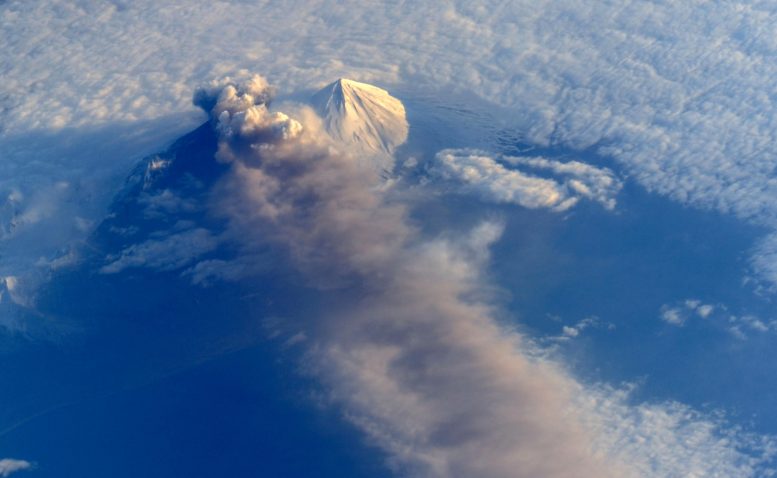Scientists from Cambridge University and NTU Singapore have found that slow-motion collisions of tectonic plates drag more carbon into Earth’s interior than previously thought.
They found that the carbon drawn into Earth’s interior at subduction zones — where tectonic plates collide and dive into Earth’s interior — tends to stay locked away at depth, rather than resurfacing in the form of volcanic emissions.
“We currently have a relatively good understanding of the surface reservoirs of carbon and the fluxes between them, but know much less about Earth’s interior carbon stores, which cycle carbon over millions of years.” — Stefan Farsang
Their findings, published in Nature Communications, suggest that only about a third of the carbon recycled beneath volcanic chains returns to the surface via recycling, in contrast to previous theories that what goes down mostly comes back up.
One of the solutions to tackle climate change is to find ways to reduce the amount of CO2 in Earth’s atmosphere. By studying how carbon behaves in the deep Earth, which houses the majority of our planet’s carbon, scientists can better understand the entire lifecycle of carbon on Earth, and how it flows between the atmosphere, oceans, and life at the surface.
The best-understood parts of the carbon cycle are at or near Earth’s surface, but deep carbon stores play a key role in maintaining the habitability of our planet by regulating atmospheric CO2 levels. “We currently have a relatively good understanding of the surface reservoirs of carbon and the fluxes between them, but know much less about Earth’s interior carbon stores, which cycle carbon over millions of years,” said lead author Stefan Farsang, who conducted the research while a PhD student at Cambridge’s Department of Earth Sciences.
There are a number of ways for carbon to be released back to the atmosphere (as CO2) but there is only one path in which it can return to the Earth’s interior: via plate subduction. Here, surface carbon, for instance in the form of seashells and micro-organisms which have locked atmospheric CO2 into their shells, is channeled into Earth’s interior. Scientists had thought that much of this carbon was then returned to the atmosphere as CO2 via emissions from volcanoes. But the new study reveals that chemical reactions taking place in rocks swallowed up at subduction zones trap carbon and send it deeper into Earth’s interior — stopping some of it coming back to Earth’s surface.
The team conducted a series of experiments at the European Synchrotron Radiation Facility, “The ESRF has world-leading facilities and the expertise that we needed to get our results,” said co-author Simon Redfern, Dean of the College of Science at NTU Singapore, “The facility can measure very low concentrations of these metals at the high pressure and temperature conditions of interest to us.” To replicate the high pressures and temperatures of subductions zones, they used a heated ‘diamond anvil’, in which extreme pressures are achieved by pressing two tiny diamond anvils against the sample.
The work supports growing evidence that carbonate rocks, which have the same chemical makeup as chalk, become less calcium-rich and more magnesium-rich when channeled deeper into the mantle. This chemical transformation makes carbonate less soluble – meaning it doesn’t get drawn into the fluids that supply volcanoes. Instead, the majority of the carbonate sinks deeper into the mantle where it may eventually become diamond.
“There is still a lot of research to be done in this field,” said Farsang. “In the future, we aim to refine our estimates by studying carbonate solubility in a wider temperature, pressure range, and in several fluid compositions.”
The findings are also important for understanding the role of carbonate formation in our climate system more generally. “Our results show that these minerals are very stable and can certainly lock up CO2 from the atmosphere into solid mineral forms that could result in negative emissions,” said Redfern. The team have been looking into the use of similar methods for carbon capture, which moves atmospheric CO2 into storage in rocks and the oceans.
“These results will also help us understand better ways to lock carbon into the solid Earth, out of the atmosphere. If we can accelerate this process faster than nature handles it, it could prove a route to help solve the climate crisis,” said Redfern.
Reference: “Deep carbon cycle constrained by carbonate solubility” by Stefan Farsang, Marion Louvel, Chaoshuai Zhao, Mohamed Mezouar, Angelika D. Rosa, Remo N. Widmer, Xiaolei Feng, Jin Liu and Simon A. T. Redfern, 14 July 2021, Nature Communications.
DOI: 10.1038/s41467-021-24533-7










I didn’t read the article.
I couldn’t get past the first sentence.
I’m probably just shouting at the void, but…
There are, No subduction zones!
There is, No continental drift!
Tectonic plates are Not pushing against each other to form mountains!
The evidence is very clear..
All geological features were formed in the One event, and have stayed that way ever since.
The continued obsession to advance the obsolete and archaic theory of subduction, is, beyond me.
Cheers Steve.
A better way to put it is that your comment is void of science – we can see subduction zones and plate tectonics (which has long since replaced the older hypothesis of continental drift) – and it seems that is because you prefer to impress your suoerstitious neliefs on nature.
But science is built on fact, and if someone is archaic in its ideas about science, it is you (re “continental drift”).
“Continental drift is the hypothesis that the Earth’s continents have moved over geologic time relative to each other, thus appearing to have “drifted” across the ocean bed.[1] The speculation that continents might have ‘drifted’ was first put forward by Abraham Ortelius in 1596. The concept was independently and more fully developed by Alfred Wegener in 1912, but his hypothesis was rejected by many for lack of any motive mechanism. Arthur Holmes later proposed mantle convection for that mechanism. The idea of continental drift has since been subsumed by the theory of plate tectonics, which explains that the continents move by riding on plates of the Earth’s lithosphere.[2]”
[ https://en.wikipedia.org/wiki/Continental_drift ]
This is very interesting. I’m surprised that this article got past the Google sensors who say global warming is mostly humans’ fault …We are still learning so much about how the Earth works and our climate.
The article obviously cannot and do not reject the observed fact of man made global warming – it is mostly humans’ fault – and instead accept it.
““We currently have a relatively good understanding of the surface reservoirs of carbon and the fluxes between them, but know much less about Earth’s interior carbon stores, which cycle carbon over millions of years,”” – Man made global warming took off only decades ago.
“… it could prove a route to help solve the climate crisis,” said Redfern.”
And that has nothing to do with conpsiracy theory on “Google censors”. Google’s own open news policies are:
“Dangerous content
Deceptive practices
Harassing content
Hateful content
Manipulated media
Medical content
Terrorist content
Sexually explicit content
Violence & gore
Vulgar language & profanity”
and science is none of that. Nor is SciTechDaily a news agency.
Meanwshile, on the climate crisis:
“COP26 climate summit president says progress made, but not enough”
“The first in-person meeting of climate ministers in 18 months has seen some tentative progress, says the UK minister who will lead the Glasgow COP26 meeting.
Alok Sharma said that the countries aligned more closely on climate issues but on some key matters they were “not yet close enough”.
One of the outstanding questions is the phasing out of coal for energy.
Continued use was incompatible with a key climate target, Mr Sharma said.”
“While there was strong support for the step, it was opposed by China and India.
There was also dissent from some G20 countries on strengthening the language around the 1.5C temperature goal in the Paris agreement, drawn up in 2015. Scientists say that we must keep the global rise in temperatures to 1.5C since industrial times if we are to avoid the most dangerous effects of warming.
The planet has already warmed around 1.2C compared to the pre-industrial era.
However, the nations did agree that they would all submit new climate pledges before the Glasgow meeting.”
“One major step forward, apart from the discussions, was that the many of the participants attended in person.
“This was the most important meeting since COP25 in Madrid (in 2019), and it turned out to be an extremely productive meeting,” said Patricia Espinosa, executive secretary of the UNFCCC at a news conference.
Mr Sharma said there was a sense among participants that the lived experience of climate change was bringing home to people the urgency of the situation.”
I.e. the many climate dead in Canada/US and Germany/Belgien of only a few weeks ago – already attributed by scientists to global warming pushing extremes – are sorrowful, daily reminders to the global population.
“Mr Sharma said that keeping the 1.5C temperature goal alive is a key outcome for Glasgow.
This will require the world to get to net zero emissions by the middle of this century and would need countries to pursue substantial emissions cuts over the next decade.
Net zero means that any greenhouse gas emissions that can’t be avoided through the use of clean technology by 2050 will either have to be buried using the technology of carbon capture and storage, or soaked up by plants and soils.
But substantial obstacles to achieving this goal remain, of which the rapid phasing out of coal is key.”
“Other participants felt that the face-to-face talks had been an improvement over the virtual meetings that have taken place for the last year-and-a-half.
“At the UK’s ministerial [meeting], the message from small island developing states appeared to be well received. This provides a level of hope that the major emitters are beginning to understand their responsibilities and should be committed to keeping the 1.5C goal in reach,” stated Minister Molwyn Joseph from Antigua and Barbuda.
“Realistically, this is going to require that we continue to press for declared commitments by the major emitters ahead of COP26 in Glasgow,” he added.”
[ https://www.bbc.com/news/science-environment-57975025 ]
Man made global warming is a hoax….a charade to help the globalist control humanity.
Earth was starving for CO2 at beginning of industrial revolution which saved our planet by discovering a way to transfer trapped carbon in ground back into atmosphere.
WILD how they lie to us!
Man made global warming is an observed fact, which tens of thousands of climate science reports agree on and which you can read up on in any useful encyclopedia (as you well know, which is why you don’t even try to provide a reference fopr your conspiracy theory).
A hoax that would involve so many scientists and politicians wouldn’t last long before being revealed, but the area is decades long. Do you really think people reading your comments would believe in *your* hoax!?
Interesting!
But this dosent give us a free hand in not stopping CO2 emissions from releasing into the atmosphere. Getting carbon into marine crustacean and then they sinking to the bottom, and then in a span of thousands of years, the subduction plates pulling them into the depths….this takes quite a while and humans are pretty fast in emitting CO2.
Lol.
Less than .02% of CO2 in atmosphere is from HUMANS.
🤣🤣🤪🤷♂️🤦🏻♂️
You’ve swallowed the propaganda
I think you may have swallowed a controlled substance. Perhaps too often.
The preindustrial level was ~ 200 ppm CO2, the current level is ~ 400 ppm.
50 % of the dominant greenhouse is caused by human society, and it has increased the global temperature with 1.2 degC. I repeat from my long comment somethin you didn’t see – I guess – and so didn’t comment on:
““This was the most important meeting since COP25 in Madrid (in 2019), and it turned out to be an extremely productive meeting,” said Patricia Espinosa, executive secretary of the UNFCCC at a news conference.
Mr Sharma said there was a sense among participants that the lived experience of climate change was bringing home to people the urgency of the situation.”
I.e. the many climate dead in Canada/US and Germany/Belgien of only a few weeks ago – already attributed by scientists to global warming pushing extremes – are sorrowful, daily reminders to the global population.”
We know this, we see this (in general).
Glad to see the trolls are out and making comments. One event, lol! Not sure what article Irene read, but this article does not say anything about human induced climate change.
Glad to see there’s a crew interested in taking it back. It’s never been like sailing on a glassy lake but at one point people could talk about topics without those who have driven themselves too insane to read anything, opting to instead make drive-by attacks with prepackaged superstition.
EARTH IS IN A HISTORIC LOW CO2 LEVEL!!!
To say it’s high is fake science. The globalists are gas lighting you!
The Earth needs MORE CO2 not less!
It’s wrong, which is why you provide no references, see my comments on the CO2 level (it has increased).
All this just goes to show climate change/global warming or whatever you choose to call it is a hoax
How!? The article describe how this will help with what you claims is “a hoax”:
“If we can accelerate this process faster than nature handles it, it could prove a route to help solve the climate crisis,” said Redfern.”
@ Steve What?!? How do you think volcanoes are formed? So you think the earths crust is stable? I guess you missed geology classes in school.